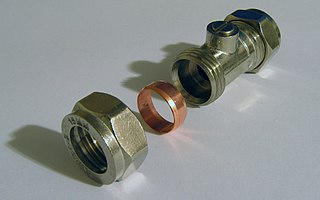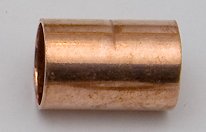
Plumbing is any system that conveys fluids for a wide range of applications. Plumbing uses pipes, valves, plumbing fixtures, tanks, and other apparatuses to convey fluids. Heating and cooling (HVAC), waste removal, and potable water delivery are among the most common uses for plumbing, but it is not limited to these applications. The word derives from the Latin for lead, plumbum, as the first effective pipes used in the Roman era were lead pipes.
A flange is a protruded ridge, lip or rim, either external or internal, that serves to increase strength ; for easy attachment/transfer of contact force with another object ; or for stabilizing and guiding the movements of a machine or its parts. Flanges are often attached using bolts in the pattern of a bolt circle.

A gasket is a mechanical seal which fills the space between two or more mating surfaces, generally to prevent leakage from or into the joined objects while under compression. It is a deformable material that is used to create a static seal and maintain that seal under various operating conditions in a mechanical assembly.

A pressure vessel is a container designed to hold gases or liquids at a pressure substantially different from the ambient pressure.
The Unified Thread Standard (UTS) defines a standard thread form and series—along with allowances, tolerances, and designations—for screw threads commonly used in the United States and Canada. It is the main standard for bolts, nuts, and a wide variety of other threaded fasteners used in these countries. It has the same 60° profile as the ISO metric screw thread, but the characteristic dimensions of each UTS thread were chosen as an inch fraction rather than a millimeter value. The UTS is currently controlled by ASME/ANSI in the United States.

A compression fitting is a fitting used in plumbing and electrical conduit systems to join two tubes or thin-walled pipes together. In instances where two pipes made of dissimilar materials are to be joined, the fittings will be made of one or more compatible materials appropriate for the connection. Compression fittings for attaching tubing (piping) commonly have compression rings, called ferrules or olives, in them, and are sometimes referred to as flareless fittings. There are also flare fittings that do not require ferrules/olives.

A screw thread, often shortened to thread, is a helical structure used to convert between rotational and linear movement or force. A screw thread is a ridge wrapped around a cylinder or cone in the form of a helix, with the former being called a straight thread and the latter called a tapered thread. A screw thread is the essential feature of the screw as a simple machine and also as a threaded fastener.

A garden hose, hosepipe, or simply hose is a flexible tube used to convey water. There are a number of common attachments available for the end of the hose, such as sprayers and sprinklers. Hoses are usually attached to a hose spigot or tap.

In plumbing and piping, a nipple is a fitting, consisting of a short piece of pipe, usually provided with a male pipe thread at each end, for connecting two other fittings.

A pipe is a tubular section or hollow cylinder, usually but not necessarily of circular cross-section, used mainly to convey substances which can flow — liquids and gases (fluids), slurries, powders and masses of small solids. It can also be used for structural applications; hollow pipe is far stiffer per unit weight than solid members.
Nominal Pipe Size (NPS) is a North American set of standard sizes for pipes used for high or low pressures and temperatures. "Nominal" refers to pipe in non-specific terms and identifies the diameter of the hole with a non-dimensional number. Specific pipe is identified by pipe diameter and another non-dimensional number for wall thickness referred to as the Schedule. NPS is often incorrectly called National Pipe Size, due to confusion with the American standard for pipe threads, "national pipe straight", which also abbreviates as "NPS". The European and international designation equivalent to NPS is DN, in which sizes are measured in millimetres, see ISO 6708. The term NB is also frequently used interchangeably with DN.
British Standard Pipe (BSP) is a set of technical standards for screw threads that has been adopted internationally for interconnecting and sealing pipes and fittings by mating an external (male) thread with an internal (female) thread. It has been adopted as standard in plumbing and pipe fitting, except in North America, where NPT and related threads are used.

A threaded pipe is a pipe with screw-threaded ends for assembly.

Thread seal tape is a polytetrafluoroethylene (PTFE) film tape commonly used in plumbing for sealing pipe threads. The tape is sold cut to specific widths and wound on a spool, making it easy to wind around pipe threads. Thread seal tape lubricates allowing for a deeper seating of the threads, and it helps prevent the threads from seizing when being unscrewed. The tape also works as a deformable filler and thread lubricant, helping to seal the joint without hardening or making it more difficult to tighten, and instead making it easier to tighten. It also protects the threads of both pieces from direct contact with each other and physical wear and helps seal and prevent leaks from the connection.

In piping and plumbing, a coupling is a very short length of pipe or tube, with a socket at one or both ends that allows two pipes or tubes to be joined, welded (steel), brazed or soldered together.
The ISO metric screw thread is the most commonly used type of general-purpose screw thread worldwide. They were one of the first international standards agreed when the International Organization for Standardization (ISO) was set up in 1947.

A fitting or adapter is used in pipe systems to connect sections of pipe or tube, adapt to different sizes or shapes, and for other purposes such as regulating fluid flow. These fittings are used in plumbing to manipulate the conveyance of fluids such as water for potatory, irrigational, sanitary, and refrigerative purposes, gas, petroleum, liquid waste, or any other liquid or gaseous substances required in domestic or commercial environments, within a system of pipes or tubes, connected by various methods, as dictated by the material of which these are made, the material being conveyed, and the particular environmental context in which they will be used, such as soldering, mortaring, caulking, Plastic welding, welding, friction fittings, threaded fittings, and compression fittings.
Pipe dope is any thread lubricant, thread sealing compound, or anaerobic chemical sealant that is used to make a pipe thread joint leakproof and pressure tight. It is also referred to as "thread compound" or "pipe thread sealant." Although common pipe threads are tapered and therefore will achieve an interference fit during proper assembly, machining and finishing variances usually result in a fit that does not result in 100 percent contact between the mating components. The application of pipe dope prior to assembly will fill the minute voids between the threads, thus making the joint pressure tight. Pipe dope also acts as a lubricant and helps prevent seizing of the mating parts, which can later cause difficulty during disassembly.

Copper tubing is most often used for heating systems and as a refrigerant line in HVAC systems. Copper tubing is slowly being replaced by PEX tubing in hot and cold water applications. There are two basic types of copper tubing, soft copper and rigid copper. Copper tubing is joined using flare connection, compression connection, pressed connection, or solder. Copper offers a high level of corrosion resistance but is becoming very costly.
Despite fire hose and hydrant coupler standardization efforts that are at least 144 years old, there remain significant areas in Canada, the United States, and Mexico that use fire hose and hydrant threads and other couplings that are incompatible with those used by neighboring fire departments. This is notable because the first fire hydrant was invented by Manhattan fire fighter George Smith in 1817, making these devices 200 years old.














